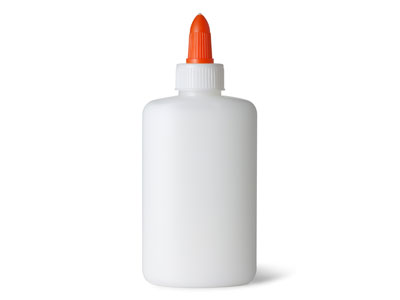How can I make glue?
Discover how to use some common kitchen ingredients to make glue.
What You Need
- 2 small paper/plastic/foam drinking cups/containers
- 1/4 cup 2% milk (skim is fine, or 2 tbsp. powdered milk with 5 tbsp. water)
- 1 tbsp. white vinegar
- 2 craft sticks for stirring
- 2 coffee filters
- 1 pinch baking soda
- Measuring spoons
What to Do
- Pour 1/4 cup of milk into one of the paper cups (or equivalent powdered milk solution).
- Add 1 tbsp. of vinegar, stir for one minute.
- Drape a coffee filter over the second cup and push the middle down so that the mixture can be poured into the filter paper
- Pour the mixture (curds and whey) into the filter. Wait until the liquid (the whey) has gone through into the cup, leaving the solid (the curds).
- Very gently squeeze the rest of the whey from the curds into the cup (the whey can be poured down the sink).
- Scrape the curds into the empty cup with a clean craft stick.
- Add a pinch of baking soda and stir well.
- Your glue is now ready! If using, allow for about six hours for the glue to dry completely.
Discovery
Milk contains a protein called casein. When you add vinegar to milk it causes the protein in the milk to "denature", which means it changes form. Similar to when we cook eggs, it turns from a liquid to a solid. The casein forms a polymer (a long chain of molecules linked together), which are the curds. The leftover liquid is the whey. The remaining curds, when mixed with baking soda create a sticky substance – like glue!
Glue, also called adhesive, can be made from a variety of different substances. Natural adhesives are made from organic sources such as vegetable starch (dextrin), natural resins, or animals (e.g. the milk protein casein and hide-based animal glues). These are some of the oldest types of adhesives. Casein glue is mainly used to stick labels to glass bottles.
- Try and find a recipe to make glue from another natural substance
- Use the glue to make a craft
- Devise a way to test the strength of your homemade glue
For more information on this topic check out these Let's Talk Science resources:
- Finding Out About Fasteners (Lessons) - Students develop and apply sorting & classifying, comparing & contrasting and communicating skills as they examine different kinds of fasteners and their uses.
- Which Fastener is Best? (Lessons) - Students investigate which fastener is best for joining different types of recycled materials to make a useful object.
What’s happening?
Milk contains a protein called casein. When you add vinegar to milk it causes the protein in the milk to "denature", which means it changes form. Similar to when we cook eggs, it turns from a liquid to a solid. The casein forms a polymer (a long chain of molecules linked together), which are the curds. The leftover liquid is the whey. The remaining curds, when mixed with baking soda create a sticky substance – like glue!
Why does it matter?
Glue, also called adhesive, can be made from a variety of different substances. Natural adhesives are made from organic sources such as vegetable starch (dextrin), natural resins, or animals (e.g. the milk protein casein and hide-based animal glues). These are some of the oldest types of adhesives. Casein glue is mainly used to stick labels to glass bottles.
Investigate further
- Try and find a recipe to make glue from another natural substance
- Use the glue to make a craft
- Devise a way to test the strength of your homemade glue
For more information on this topic check out these Let's Talk Science resources:
- Finding Out About Fasteners (Lessons) - Students develop and apply sorting & classifying, comparing & contrasting and communicating skills as they examine different kinds of fasteners and their uses.
- Which Fastener is Best? (Lessons) - Students investigate which fastener is best for joining different types of recycled materials to make a useful object.
